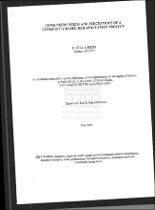| dc.description.abstract | It is estimated that at least 7%o of the world's population suffer from various types of disabilities. Of this population, two thirds are residing in developing countries (WHO, 1995). According to the 1996 Census, the prevalence rate for disability in South Africa is 6.60/o (Statistics South Africa, 1998). Despite a high prevalence of disability, most people with disabilities in developing countries, if they received any services at all, have experienced only a medical model of rehabilitation which treat them as passive recipients of rehabilitation services. The World Health Organization (WHO) promoted Community-based Rehabilitation (CBR) in an attempt to de-institutionalise rehabilitation and as an approach for providing services to people with disabilities, particularly in developing countries (WHO, 1994). CBR promotes awareness and responsibility for rehabilitation in the community. There is an expectation that the community and people with disabilities themselves should be actively involved in the planning and evaluation of CBR programmes. In outlining guidelines for the monitoring of CBR programmes WHO
(1996) stresses that it is important to explore if people with disabilities feel that their needs are met when rehabilitation programmes are evaluated. Rehabilitation services in South Africa are in a process of transformation (Office of the Deputy President, 1997, Department of Health, 2000). This involves an increasing willingness on the part of service providers to engage in partnerships with people with
disabilities in the planning and delivery of services. The need for increased consumer involvement in rehabilitation services is emphasized
in the literature. Social change, legislative initiatives, growing empowerment among consumer groups and changes in service intervention strategies have increased awareness and demands of persons who utilize rehabilitation services. With regards to obtaining consumer opinion, researchers such as Hawkins (1991) have stressed that the needs of persons seeking services are individualized. Consequently, their
expectations and perceptions of services will likely influence their opinions regarding the success or failure of services that they receive. | en_US |

